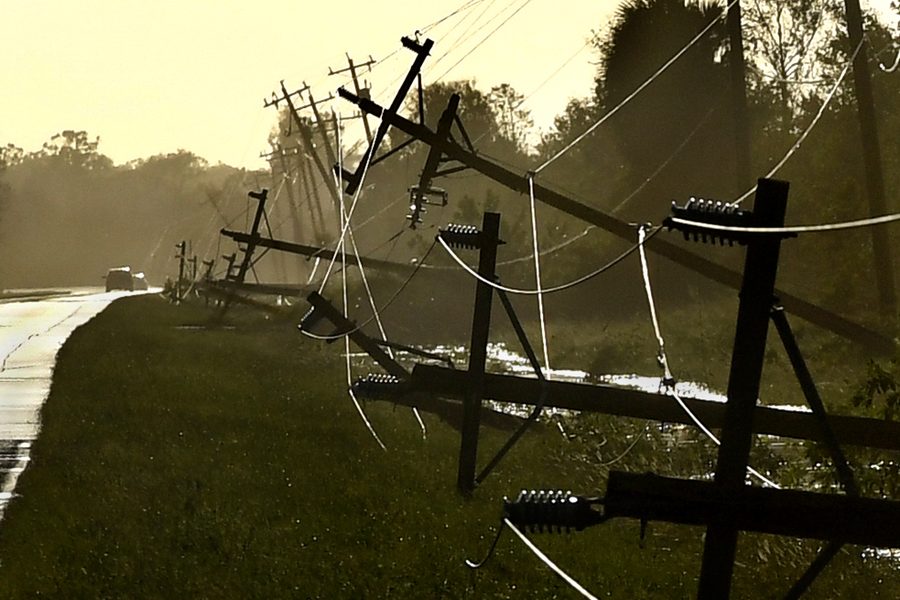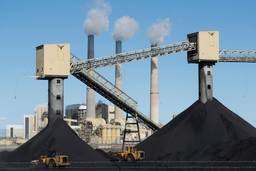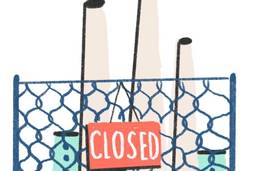After Irma, Can Private Utilities Be Trusted to Rebuild?
There’s an opportunity post-Irma to revolutionize Florida’s power supply, but Big Energy is not likely to rise to the occasion.
Kate Aronoff

In the coming days, millions of Floridians will return home to rebuild in the aftermath of Hurricane Irma. Also now tasked with rebuilding are Florida’s major utilities — companies like NextEra Energy, Inc., Duke Energy and Emera Inc.
These companies face a choice: To double down on a utility model that’s vulnerable to storms and fueling more brutal ones, or start transitioning to a grid better equipped to handle hurricanes — and help keep them from getting worse. The question is whether they can be trusted to choose well.
As of Friday, roughly 3.8 million Florida residents were without power. The state’s utilities will have to restore electricity to their customers while reconstructing vast swaths of the state’s transmission lines and generating capacity. Florida Power & Light Company (FPL) — a NextEra subsidiary and the nation’s third-largest power provider—warns that it could take weeks before all of its customers are able to turn their lights back on. FPL president and CEO Eric Silagy called the scale of the outages “unprecedented,” and one communications representative from the same utility said that what lies ahead “is going to be a very, very lengthy restoration, arguable the longest and most complex in U.S. history.”
There’s an opportunity post-Irma to revolutionize Florida’s power supply, but not one that companies like FPL are likely to take advantage of. As a recent report from InsideClimate News found, FPL started sponsoring research into climate change in the early 1970s before eventually getting involved in efforts to suppress evidence of rising temperatures. The Southern Company, which owns Panhandle electricity provider Gulf Power, for decades contributed to public relations campaigns casting doubt on the existence of climate change, and funneled hundreds of thousands of dollars into bogus climate skeptic research.
Like their counterparts in other states, Florida utilities have gone to war with clean energy, too. Last year, they poured a collective $21 million ($8 million from FPL alone) into an unsuccessful ballot measure aimed at stunting various kinds of third-party financing for solar power. Beyond that effort, investor-owned utilities are a force to reckon with in Florida politics; the sector employs one lobbyist for every two state legislators — the most of any industry. This spring, FPL was found to have written whole sections of anti-solar legislation sponsored by state representative Ray Rodriguez, who had previously accepted $15,000 from the utility.
With major utilities aligned in opposition, the road to renewables’ proliferation in Florida may not be an easy one. John Farrell, director of the Energy Democracy Initiative at the Institute for Local Self-Reliance, says that policies to transition Florida’s electricity over to renewables could go a long way toward being able to get lights back on more quickly after major storms.
In an ideal rebuilding process, Farrell told In These Times, “What we would see is, from a policy standpoint, that [utilities] would be more supportive of ways customers could build their own power generation. In a system like we have today, if one power line is knocked out, it can affect tens of thousands of people … If we have lots of different pockets of generation, we can figure out ways to fill in the gaps.”
The system Farrell describe is what’s known as a microgrid. The basic idea behind a microgrid is to have a bounded geographic area reliant on the same set of power sources that can be operated independently of a larger electric grid, or “islanded,” in energy-wonk parlance. This allows homes and businesses to share power, meaning if power gets shut off during a storm, entities that get their power from the microgrid can keep their lights on.
Under Florida law and that of several other states, such a practice is illegal, as it would mean undercutting utilities’ legally protected monopoly. The vast majority of solar arrays are currently tied to the electric grid by law, meaning they shut down when the power goes off.
Unsurprisingly, FPL lobbyists have fought to keep this statute on the books. If utilities allowed microgrids — whether servicing large institutions or small commercial and residential areas — they could help maintain power in a deluge. Instead, according to FPL policy, even ratepayers with solar panels, who could feasibly keep their lights on during an outage, are forbidden from doing so. “Renewable generator systems connected to the grid without batteries are not a standby power source during an FPL outage,” the utility’s handbook states.
The problem, Farrell notes, is rooted in FPL and other private electricity providers’ business model. “This is true of investor-owned utilities in all states like Florida, where there are monopolies: Their money for the shareholders comes from getting a rate of return from capital they spend, and building something like a power plant,” he told me. “The utility can build a microgrid and make money from it, but that would mean doing something different.”
Being able to keep power on in the way that microgrids allow for could prove especially useful for places like hospitals and other institutions that provide essential and energy-dependent services. It may have even saved lives this past week. Thirty-six hospitals in Florida closed as a result of Irma, and eight people were found dead in a sweltering Hollywood, Fl. nursing home where a power outage left more than 100 residents without air conditioning. (Exact causes of death are still being investigated.)
It’s not as if there aren’t examples of what a more innovative recovery could look like. In the wake of Hurricane Sandy, storm-impacted states extended financing to towns that wanted to develop microgrids. As a result, Connecticut became the first state to roll out a statewide microgrid program for businesses and public services to maintain power during outages, and cities such as Hoboken, N.J. and Fairfield, Conn. each accepted their states’ offers.
New York launched a $40 million competition called New York Prize, aimed at making power systems more resilient, with a focus on microgrid technology. Sandy was a launch pad for New York’s “Reforming the Energy Vision,” a 2013 plan to drastically alter the state’s energy regulation landscape. Even New York City’s biggest and hardly progressive utility providers — PSEG and ConEd — launched new grid management programs in the months after the storm.
Like PSEG and ConEd in New York, there are plenty of players jumping on the microgrid bandwagon for purely pragmatic reasons. Former FERC chair John Wellinghoff sung their praises, citing the threats to cybersecurity posed by a highly centralized grid. The Department of Defense recognizes microgrids as a key way to protect electricity against terrorism and cyberattacks. Following a directive in 2011’s National Defense Authorization Act, the military is currently deploying them in its operations around the world. Rick Perry’s Department of Energy recently announced that it would devote $50 million to research into microgrids.
Microgrids are even making some headway in Florida. Duke Energy — another major electricity provider there — had shown interest in microgrids even before Irma. The utility is part of a $32 million push from the Department of Energy into Resilient Distribution Systems. The initiative is one part of a $50 million funding round that includes $20 million for a series of cybersecurity projects.
Distributed energy is also trendy in Silicon Valley, as well as often-overlapping green tech circles. In the Bay Area, Tesla and the city of San Francisco are each working to get microgrids online in the event of a major earthquake. One green tech summit in Oakland last year, VERGE16, powered itself entirely off of a microgrid.
The tech sector’s excitement makes sense. To major — and especially monopoly — utilities, microgrids are an inherently disruptive technology, and replicate some of the libertarian-tinged sharing economy ethos that animates everything from Uber to Airbnb.
Also like those services, what’s being traded isn’t the goodwill of strangers, but real money. In that context, the scalar concerns that come with microgrids’ promise seem almost self-evident: If utilities allow them and there’s a local appetite for it, communities that can afford to create a microgrid will. For others, the financial barriers to such a drastic transition may well prove too high, especially in more rural areas with already aged infrastructure. That’s where utilities can come in.
“Maybe they use their staff to help construct the project…maybe they help finance the system, or build the circuitry,” Farrell says. “There are a lot of ways that utilities could provide their expertise that are different rom simply being the sole provider of electricity.” Critically, big utilities could help level the playing field to help more communities access clean, reliable and storm-resilient power.
When it comes to investor-owned utilities, the issue isn’t whether the technology for such transformations is available, but whether there are profits to be made. For poor neighborhoods, that may not always be the case. This means that even an earnest embrace of renewables and more distributed forms of energy generation could splinter unevenly — leaving more well-off ratepayers with state-of-the-art, clean-running power that can operate during a storm — and everyone else reliant on outmoded fuel and infrastructure.
The dilemmas facing microgrids are those facing renewables more generally. While the recent growth of microgrids has been exciting, a massive investment in both research and development — and actual construction — is needed to bring such systems to scale. There’s also no federal plan for what the transition away from fossil fuels could look like. The federal government and several state governments — Florida’s included — seem committed to making sure that transition never happens. And even if there is political will to get off of fossil fuels, how that transition is carried out could make the difference between a climate-changed future — rife with inequalities — and one that preserves every other form of inequality that’s baked into our current economy, only with more solar panels and wind turbines. Whether companies are interested in developing microgrids is a different question from whether they’ll help ensure everyone can access them.
As Hurricane Katrina showed, corporations and corporate-friendly governments are more than willing to swoop in after a major disaster to pull public goods into the private sector. In Texas, Houston has already appointed a former Shell CEO to head its post-Harvey recovery operation.
The question Irma poses is whether the opposite can happen. If utilities like FPL aren’t willing to make the kinds of investments needed to save lives when the worst happens, what alternatives can take their place? And what does the fight look like to beat them politically? As the climate crisis accelerates, Americans will face a fight over their power in more ways than one — especially just after a disaster strikes.
Kate Aronoff is a staff writer at The New Republic and author of Overheated: How Capitalism Broke the Planet — And How We Fight Back. She is co-author of A Planet To Win: Why We Need a Green New Deal and co-editor of We Own the Future: Democratic Socialism—American Style. Follow her on Twitter @katearonoff.








